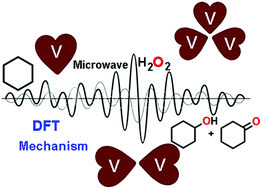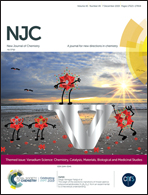Vanadium complexes of different nuclearities in the catalytic oxidation of cyclohexane and cyclohexanol – an experimental and theoretical investigation†
Abstract
The mono-, bi- and tri-nuclear oxidovanadium(V) complexes [VO(OEt)(L1)] (1), [{VO(OEt)(EtOH)}2(L2)] (2) and [{VO(OMe)(H2O)}3(L3)]·2H2O (3) (L1 = 2-hydroxy-(2-hydroxybenzylidene)benzohydrazide, L2 = bis(2-hydroxybenzylidene)terephthalohydrazide and L3 = tris(2-hydroxybenzylidene)benzene-1,3,5-tricarbohydrazide) (3 was synthesized for the first time) were used to investigate the role of vanadium nuclearity in the catalytic oxidation of cyclohexane and cyclohexanol. They are active homogeneous catalysts for the microwave-assisted neat peroxidative oxidation of cyclohexane (with aq. H2O2 to cyclohexanol and cyclohexanone) and cyclohexanol (with aq. tBuOOH to cyclohexanone). A mechanism of the HO˙ radical generation – the rate limiting step of the cyclohexane oxidation by H2O2 – was investigated in detail by theoretical DFT methods. The mechanism is different from those usually accepted for the Fenton or Fenton-like systems and it includes (i) coordination of H2O2 to the catalyst molecule, (ii) proton transfer from ligated H2O2 to the methoxy ligand and elimination of the formed methanol molecule and (iii) coordination of the second H2O2 molecule followed by HO–OH bond cleavage to give HO˙. The activation of the ligated H2O2 towards this cleavage is associated with the redox active nature of the ligand L in the catalyst molecule, which acts (instead of the metal) as the reducing agent of the H2O2 ligand.

- This article is part of the themed collection: Vanadium Science: Chemistry, Catalysis, Materials, Biological and Medicinal Studies


 Please wait while we load your content...
Please wait while we load your content...